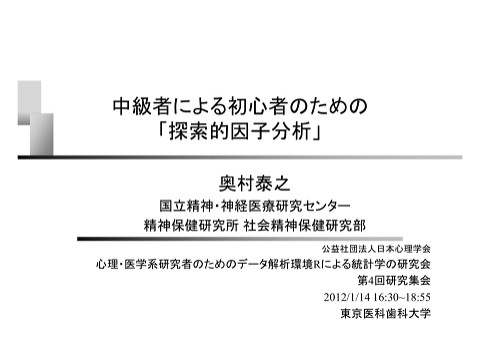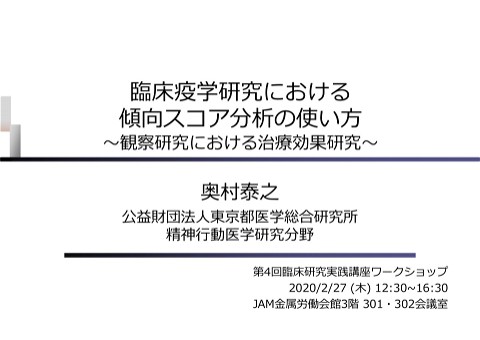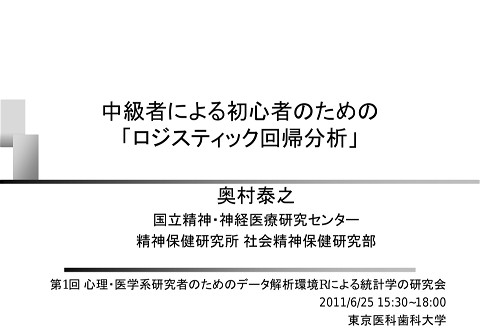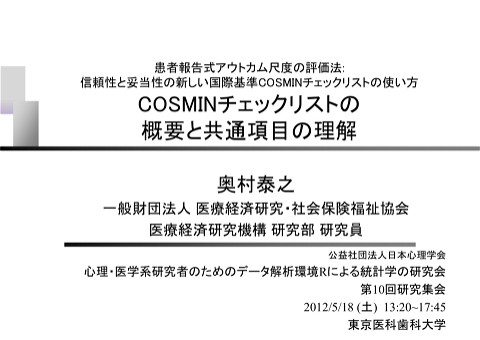「傾向スコア分析」の書き方
92.6K Views
May 24, 22
スライド概要
関連スライド

中級者による初心者のための「綿形混合モデル」
 奥村 泰之
217.3K
奥村 泰之
217.3K

中級者による初心者のための「探索的因子分析」
 奥村 泰之
63.2K
奥村 泰之
63.2K

研究疑問とマッチした研究計画・統計解析の選び方
 奥村 泰之
30.4K
奥村 泰之
30.4K
各ページのテキスト
「傾向スコア分析」の書き方 傾 分析」 書 方 奥村泰之 国立精神・神経医療研究センター 国立精神 神経医療研究センタ 精神保健研究所 社会精神保健研究部 公益社団法人日本心理学会 心理・医学系研究者のためのデータ解析環境Rによる統計学の研究会 第 第8回研究集会 究 2012/12/8 16:00~18:50 東京医科歯科大学
特徴 第1部 第2部 第3部 落ち葉拾い R 推薦⽂献 構成 傾向スコア分析の特徴 ((8 min)) 項目詳細 第1部: 第 部 共変量の選択根拠とPS推定 共変量 選択根拠と 推定 (8 min) 第2部: マッチング法 (12 min) 第3部: バランスの確認と効果の推定 (8 min) 落ち葉拾い (6 min) Rによる傾向スコア分析 (0 min) 中級者向けの推薦文献 中級者向けの推薦文献 (1 min) 2
特徴 第1部 第2部 第3部 落ち葉拾い R 推薦⽂献 英語表記 Propensity Score Analysis/Methods Matching Methods 3
特徴 第1部 第2部 第3部 落ち葉拾い R 推薦⽂献 変数の役割と尺度水準 1つの従属変数 量的変数/質的変数/イベント発生までの時間 • 生活の質,生きている/死んでいる,生存時間 生活の質 生きている/死んでいる 生存時間 1つの割り当て変数 名義尺度 (2水準が中心) • 暴露群/非暴露群 1つ以上の共変量 以 の共変量 量的変数/質的変数 共変量 割り当て変数 従属変数 4
特徴 第1部 第2部 第3部 落ち葉拾い R 推薦⽂献 傾向スコア分析の使用目的 従属変数のデータの測定後に傾向スコア分 析を行い,選択バイアスを減らして,治療の 効果を検討する 従属変数のデータの測定前に傾向スコア分 従属変数 タ 測定前 傾 分 析を行い,追跡する集団を限定する Stuart EA: Stat Sci 25:1-21, 2010 . 5
特徴 第1部 第2部 第3部 落ち葉拾い R 推薦⽂献 事例①測定後 目的 認知症患者への非定型抗精神病薬と定型薬の死亡リ スクの相違 従属変数 抗精神病薬の投与開始後180日以内の全死亡 割り当て変数 非定型薬 vs 定型薬 共変量 認知症重症度,90日前の入院の有無,年齢など Gill SS et al: Ann Intern Med 146:775-86, 2007. 6
特徴 第1部 第2部 第3部 落ち葉拾い R 推薦⽂献 事例②測定前 目的 妊娠中のphenobarbital処方は,胎児の成長後の 知能に影響するか 割り当て変数 phenobarbital処方あり (33名) vs 処方なし (3308 名) 共変量 社会経済的地位,父親の有無など 従属変数 胎児の成長後の知能 Reinisch JM et al: JAMA 274: 1518-25, 1995. 7
特徴 第1部 第2部 第3部 落ち葉拾い R 推薦⽂献 解析の手順 傾向スコアの推定 傾向スコアの推定値の利用法 傾 推定値 利用法 マッチング 層化 IP(T)W ( ) 共変量 バランスの確認 効果の推定 8
特徴 第1部 第2部 第3部 落ち葉拾い R 推薦⽂献 適正報告調査 論文 (赤字は推薦文献) G Gayatt E ett al: l P Propensity it scores iin iintensive t i care and d anaesthesiology th i l lit t literature: a systematic review (Intensive Care Med 36: 1993-2003, 2010) Austin PC: A critical appraisal of propensity-score matching in the medical literature between 1996 and 2003 (Stat Med 27:2037-49, 27:2037 49, 2008) Austin PC: Primer on statistical interpretation or methods report card on propensityscore matching in the cardiology literature from 2004 to 2006: a systematic review (Circ Cardiovasc Qual Outcomes 1: 62-7, 2008) Austin PC: Propensity-score matching in the cardiovascular surgery literature from 2004 to 2006: a systematic review and suggestions for improvement (J Thorac Cardiovasc Surg 134:1128-35, 2007) Stürmer T et al: A review of the application of propensity score methods yielded increasing use, advantages in specific settings, but not substantially different estimates compared with conventional multivariable methods (J Clin Epidemiol 59: 437-47, 2006) Shah BR et al: Propensity score methods gave similar results to traditional regression modeling in observational studies: a systematic review (J Clin Epidemiol 58: 550-9, 2005) Weitzen S et al: Principles for modeling propensity scores in medical research: a systematic literature review (Pharmacoepidemiol Drug Saf 13: 841-53, 2004) 9
特徴 第1部 第2部 第3部 落ち葉拾い R 推薦⽂献 Austinの適正報告調査 結果 報告すべき点 報告率[1] (1) ① 共変量の選択根拠 ―― (1)-① (1)-② 傾向スコアの推定 ―― 48% (29/60) (2) マッチング法の記述 チング法の記述 0% (0/60) (3) バランスの確認 13% (8/60) (4) 効果の推定 報告率[2] 報告率[3] ―― ―― 55% (24/44) 0% (0/44) 25% (11/44) 96% (45/47) ―― 68% (32/47) 4% (2/47) 28% (13/47) [1] Austin PC: J Thorac Cardiovasc Surg 134:1128-35, 2007. [2] Austin PC: Circ Cardiovasc Qual Outcomes 1: 62-7, 2008. [3] Austin PC: Stat Med 27:2037-49, 2008. 10
特徴 第1部 第2部 第3部 落ち葉拾い R 推薦⽂献 構成 傾向スコア分析の特徴 ((8 min)) 項目詳細 第1部: 第 部 共変量の選択根拠とPS推定 共変量 選択根拠と 推定 (8 min) 第2部: マッチング法 (12 min) 第3部: バランスの確認と効果の推定 (8 min) 落ち葉拾い (6 min) Rによる傾向スコア分析 (0 min) 中級者向けの推薦文献 中級者向けの推薦文献 (1 min) 11
特徴 第1部 第2部 第3部 落ち葉拾い R 推薦⽂献 (1)-① (1) ① 共変量の選択根拠 基準 共変量の選択根拠を記載すること 選択根拠 先行研究 専門家の意見 相関係数 Austin PC: Stat Med 27:2037-49, 2008. 共変量 割り当て変数 従属変数 12
特徴 第1部 第2部 第3部 落ち葉拾い R 推薦⽂献 (1)-① (1) ① 共変量の選択根拠 共変量の適格基準 ×従属変数 ×中間変数 • 暴露により値が変化しうる変数 ○暴露前/時に測定された変数 Austin PC et al: Analysis of observational health care data using SAS (pp51-84). SAS press. 2010. 13
特徴 第1部 第2部 第3部 落ち葉拾い R 推薦⽂献 (1)-① (1) ① 共変量の選択根拠 共変量選択の4方略の利点と欠点 ①従属変数に影響する変数 (potential confounder) ②従属変数と割り当て変数の両者に影響する 共変量 (true confounder) ③割り当て変数に影響する共変量 ④測定しているすべての共変量 観点 ①従属変数 ②両者 ③割り当て変数 ④すべて 効果の推定精度 ○ ○ × × 複数の従属変数を同一の共変量 × × ○ ○ Austin PC et al: Analysis of observational health care data using SAS (pp51-84). SAS press. 2010. 14
特徴 第1部 第2部 第3部 落ち葉拾い R 推薦⽂献 (1)-① (1) ① 共変量の選択根拠 事例 方法の節 (先行研究/従属変数) » The PS model was estimated using a logistic regression model that adjusted for the patient characteristics listed in Table 1, as well as admissions vital signs and laboratory values (31 variables in total), as these variables were shown to be prognostically significant in other studies [18]. Abrahamyan L et al: Int J Qual Health Care 24:425-32, 2012. 15
特徴 第1部 第2部 第3部 落ち葉拾い R 推薦⽂献 (1)-① (1) ① 共変量の選択根拠 事例 方法の節 (専門家の意見/従属変数) » Possible confounders were chosen for their potential association with the outcome of interest based on clinical knowledge. The predicted probability of preprocedural stains was calculated by fitting a logistic regression model model, using all clinically relevant variables as shown in Table 1. Ko DT et al: Circ Cardiovasc Qual Outcomes 4:459-66, 2011. 16
特徴 第1部 第2部 第3部 落ち葉拾い R 推薦⽂献 (1)-① (1) ① 共変量の選択根拠 事例 方法の節 (相関係数/従属変数) » Covariates were carefully selected based on the assumption that none was affected directly by the intervention. Other a priori selected variables were planned for inclusion in the final statistical models ...(中略)... models. (中略) » Variables were considered for inclusion in the final models after calculating correlation coefficients, examining scatterplot matrices, and ensuring that the proportion of missing data was below 20%. Galvagno SM et al: JAMA 307:1602-10, 2012. 17
特徴 第1部 第2部 第3部 落ち葉拾い R 推薦⽂献 (1)-② (1) ② 傾向スコアの推定 基準 傾向スコアの推定法を記載すること 傾向ス アの定義 傾向スコアの定義 正式 • 観測した共変量が与えられた条件下で,ある因子 に暴露する条件付き確率 直感的 • ある人の暴露前の特性を考慮したときに,ある人 が暴露群になる確率 Trojano M et al: Int MS J 16: 90-7, 2009. 18
特徴 第1部 第2部 第3部 落ち葉拾い R 推薦⽂献 (1)-② (1) ② 傾向スコアの推定 傾向スコアの推定のための統計手法 ロジスティック回帰分析 (logistic regression) プロビ ト回帰分析 (probit regression) プロビット回帰分析 判別分析 判別分析 ((discriminant analysis) y ) 決定木 (classification and regression trees) ニューラルネットワーク ネ ト ク (neural networks) 一般化加法モデル 般化加法モデル (generalized additive models) 多項ロジットモデル (multinomial logistic regression) Austin PC et al: Analysis of observational health care data using SAS (pp51-84). SAS press. 2010. 19
特徴 第1部 第2部 第3部 落ち葉拾い R 推薦⽂献 (1)-② (1) ② 傾向スコアの推定 傾向スコアの推定のためのモデル 従属変数 (Z) • 割り当て変数 (暴露群/非暴露群) 独立変数 (X) • 共変量 共変量 割り当て変数 従属変数 20
特徴 第1部 第2部 第3部 落ち葉拾い R 推薦⽂献 (1)-② (1) ② 傾向スコアの推定 傾向スコアの推定のためのモデル 傾向スコアの推定値 ( êi ) • ロジスティック回帰分析などの予測値 eˆi pr ( zi 暴露群 | xi ) • 標本サイズ (n) と同じ長さのベクトル 得点可能範囲は • 得点可能範囲は0~1 共変量 割り当て変数 従属変数 21
特徴 第1部 第2部 第3部 落ち葉拾い R 推薦⽂献 (1)-② (1) ② 傾向スコアの推定 事例 方法の節 » Possible confounders were chosen for their potential association with the outcome of interest based on clinical knowledge. The predicted probability of preprocedural statins was calculated by fitting a logistic regression model model, using all clinically relevant variables as shown in Table 1. Ko DT et al: Circ Cardiovasc Qual Outcomes 4:459-66, 2011. 22
特徴 第1部 第2部 第3部 落ち葉拾い R 推薦⽂献 構成 傾向スコア分析の特徴 ((8 min)) 項目詳細 第1部: 第 部 共変量の選択根拠とPS推定 共変量 選択根拠と 推定 (8 min) 第2部: マッチング法 (12 min) 第3部: バランスの確認と効果の推定 (8 min) 落ち葉拾い (6 min) Rによる傾向スコア分析 (0 min) 中級者向けの推薦文献 中級者向けの推薦文献 (1 min) 23
特徴 第1部 第2部 第3部 落ち葉拾い R 推薦⽂献 (2) マッチング法の記述 基準 マッチング法の詳細を記載すること 詳細 マッチングのアルゴリズム 抽出法 キャリパーの指定 構成比 Austin PC: Multivariate Behav Res 46: 399-424, 2011. 24
特徴 第1部 第2部 第3部 落ち葉拾い R 推薦⽂献 (2) マッチング法の記述 マッチングのアルゴリズム 種類 • Greedy matching – Nearest neighbor matching – Mahalanobis M h l bi metric t i matching t hi • Optimal matching Guo S, Fraser MW: Propensity score analysis: statistical methods and applications. Sage. 2011. 25
特徴 第1部 第2部 第3部 落ち葉拾い R 推薦⽂献 (2) マッチング法の記述 マッチングのアルゴリズム Nearest neighbor matching • ①暴露群から無作為に1人選択 • ②非暴露群から,①で選択した人の傾向スコアと, 最も類似の傾向 最も類似の傾向スコアの人をペアとする アの人をペアとする • ③上記の①~②を複数回反復 暴露群の傾向スコア eˆi 0 eˆi 1 非暴露群の傾向スコア Austin PC: Multivariate Behav Res 46: 399-424, 2011. 26
特徴 第1部 第2部 第3部 落ち葉拾い R 推薦⽂献 (2) マッチング法の記述 マッチングのアルゴリズム Nearest neighbor matching ID t1 t2 t3 t4 t5 t6 c1 c2 c3 c4 c5 c6 PS 0.48 0.97 0 69 0.69 0.68 0.96 0.34 0.31 0.00 0.74 0.02 0 52 0.52 0.29 Nearest neighbor matching 暴露群 非暴露群 ID PS1 ID PS2 |PS1-PS2| t1 0.48 c5 0.52 0.04 t2 0.97 c3 0.74 0.23 t3 0.69 0 69 c1 0.31 0 31 0 37 0.37 t4 0.68 c6 0.29 0.39 t5 0.96 c4 0.02 0.93 t6 0.34 0 34 c2 2 0.00 0 00 0 34 0.34 2.31 Austin PC: Multivariate Behav Res 46: 399-424, 2011. 距離のレンジは 0.04~0.93 距離の合計は 2.31 27
特徴 第1部 第2部 第3部 落ち葉拾い R 推薦⽂献 (2) マッチング法の記述 マッチングのアルゴリズム Optimal matching • ペア内の傾向スコアの距離の合計が最小になるペ アを作る Austin PC: Multivariate Behav Res 46: 399-424, 2011. 28
特徴 第1部 第2部 第3部 落ち葉拾い R 推薦⽂献 (2) マッチング法の記述 マッチングのアルゴリズム Optimal matching ID t1 t2 t3 t4 t5 t6 c1 c2 c3 c4 c5 c6 PS 0.48 0.97 0 69 0.69 0.68 0.96 0.34 0.31 0.00 0.74 0.02 0 52 0.52 0.29 Optimal matching 暴露群 非暴露群 ID PS1 ID PS2 |PS1-PS2| t1 0.48 c6 0.29 0.19 t2 0.97 c4 0.02 0.95 t3 0.69 0 69 c5 0.52 0 52 0 16 0.16 t4 0.68 c2 0.00 0.68 t5 0.96 c3 0.74 0.21 t6 0.34 0 34 c1 1 0.31 0 31 0 03 0.03 2.22 Austin PC: Multivariate Behav Res 46: 399-424, 2011. 距離のレンジは 0.03~0.95 距離の合計は 2.22 29
特徴 第1部 第2部 第3部 落ち葉拾い R 推薦⽂献 (2) マッチング法の記述 抽出法 種類 • 非復元抽出 (without ( replacement)) • 復元抽出 (with replacement) Austin PC: Multivariate Behav Res 46: 399-424, 2011. 30
特徴 第1部 第2部 第3部 落ち葉拾い R 推薦⽂献 (2) マッチング法の記述 抽出法 非復元抽出 • 暴露群のペアとして同一の非暴露群の人を,複数 暴露群のペアとして同 の非暴露群の人を 複数 回使用できない 復元抽出 復 抽出 • 暴露群のペアとして同一の非暴露群の人を,複数 暴露群の アとして同 の非暴露群の人を,複数 回使用できる • 滅多に使われない Austin PC: Multivariate Behav Res 46: 399-424, 2011. 31
特徴 第1部 第2部 第3部 落ち葉拾い R 推薦⽂献 (2) マッチング法の記述 抽出法 復元抽出 ID t1 t2 t3 t4 t5 t6 c1 c2 c3 c4 c5 c6 PS 0.48 0.97 0 69 0.69 0.68 0.96 0.34 0.31 0.00 0.74 0.02 0 52 0.52 0.29 Nearest neighbor matching with replacement 暴露群 非暴露群 ID PS1 ID PS2 |PS1-PS2| |PS1 PS2| t1 0.48 c5 0.52 0.04 t2 0.97 c3 0.74 0.23 t3 0.69 c3 0.74 0.06 t4 0.68 c3 0.74 0.07 t5 0.96 96 c3 0.74 0.21 t6 0.34 c1 0.31 0.03 0.63 Austin PC: Multivariate Behav Res 46: 399-424, 2011. c3は4回使用 32
特徴 第1部 第2部 第3部 落ち葉拾い R 推薦⽂献 (2) マッチング法の記述 キャリパーの指定 指定法 • 一定の傾向スコアの距離 定の傾向スコアの距離 (キャリパー) (キャリパ ) に収まる人 をマッチングの対象とする 推奨値 推奨値 • 傾向スコアの推定値をロジット変換したベクトルの 傾向 アの推定値を ジット変換した クトルの 標準偏差に0.2を乗じた値が推奨 Austin PC: Multivariate Behav Res 46: 399-424, 2011. 33
特徴 第1部 第2部 第3部 落ち葉拾い R 推薦⽂献 (2) マッチング法の記述 類似性の基準 Nearest neighbor matching ID t1 t2 t3 t4 t5 t6 c1 c2 c3 c4 c5 c6 PS 0.48 0.97 0 69 0.69 0.68 0.96 0.34 0.31 0.00 0.74 0.02 0 52 0.52 0.29 Nearest neighbor matching 暴露群 非暴露群 ID PS1 ID PS2 |PS1-PS2| t1 0.48 c5 0.52 0.04 t2 0.97 0 97 c3 0.74 0 74 0 23 0.23 t3 0.69 c1 0.31 0.37 t4 0.68 c6 0.29 0.39 t5 5 0.96 0 96 c4 4 0.02 0 02 0 93 0.93 t6 0.34 c2 0.00 0.34 Austin PC: Multivariate Behav Res 46: 399-424, 2011. 一部距離が大きい 34
特徴 第1部 第2部 第3部 落ち葉拾い R 推薦⽂献 (2) マッチング法の記述 類似性の基準 キャリパーの指定 ID t1 t2 t3 t4 t5 t66 c1 c2 c3 c4 c5 c6 PS 0.48 0.97 0 69 0.69 0.68 0.96 0 34 0.34 0.31 0.00 0.74 0.02 0.52 0.29 Nearest neighbor matching within caliper p width of 0.3 暴露群 非暴露群 ID PS1 ID PS2 |PS1-PS2| t1 0.48 0 48 c1 0.31 0 31 0 17 0.17 t2 0.97 c3 0.74 0.23 t3 0.69 c5 0.52 0.16 t4 4 0.68 0 68 t5 0.96 t6 0.34 c6 0.29 0.05 Austin PC: Multivariate Behav Res 46: 399-424, 2011. 距離を0.3以内 35
特徴 第1部 第2部 第3部 落ち葉拾い R 推薦⽂献 (2) マッチング法の記述 構成比 種類 • One-to-one One to one pair matching • Many-to-one (M:1) matching • Full matching Austin PC: Multivariate Behav Res 46: 399-424, 2011. 36
特徴 第1部 第2部 第3部 落ち葉拾い R 推薦⽂献 (2) マッチング法の記述 構成比 One-to-one pair matching • 1名の暴露群と1名の非暴露群でマッチング Many-to-one (M:1) matching • 1名の暴露群とM名の非暴露群でマッチング Full matching • 1名の暴露群と複数名の非暴露群,1名の非暴露 群と複数名の暴露群でマ チングの組み合わせ 群と複数名の暴露群でマッチングの組み合わせ Austin PC: Multivariate Behav Res 46: 399-424, 2011. 37
特徴 第1部 第2部 第3部 落ち葉拾い R 推薦⽂献 (2) マッチング法の記述 構成比 Many-to-one (M:1) matching 暴露群の傾向スコア eˆi 0 eˆi 1 非暴露群の傾向スコア Austin PC: Multivariate Behav Res 46: 399-424, 2011. 38
特徴 第1部 第2部 第3部 落ち葉拾い R 推薦⽂献 (2) マッチング法の記述 構成比 Full matching 暴露群の傾向スコア eˆi 0 eˆi 1 非暴露群の傾向スコア Austin PC: Multivariate Behav Res 46: 399-424, 2011. 39
特徴 第1部 第2部 第3部 落ち葉拾い R 推薦⽂献 (2) マッチング法の記述 事例 方法の節 (nearest/非復元抽出/0.2SD-logit/M:1) » One TRI [TransRadial Intervention] patient was matched to many TFI [TransFemoral Intervention] patients using nearest-neighbor matching without replacement. Propensity scores were matched using a caliper width 1/5 logit of the SD SD,25 and exact matches were performed on anticoagulant used, year of PCI, and risk of bleeding. Safley DM et al: Am Heart J: in press. 40
特徴 第1部 第2部 第3部 落ち葉拾い R 推薦⽂献 (2) マッチング法の記述 事例 方法の節 (optimal/非復元抽出/0.03/1:1) » In addition addition, to reduce the effect of treatment-selection treatment selection bias and potential confounding in this observational study, we performed rigorous adjustment for significant differences in the baseline characteristics of patients with propensity propensity-score score matching using the following algorithm: 1:1 optimal match with a ±0.03 caliper and no replacement. Chieffo A et al: JACC Cardiovasc Interv 5: 718-27, 2012. 41
特徴 第1部 第2部 第3部 落ち葉拾い R 推薦⽂献 構成 傾向スコア分析の特徴 ((8 min)) 項目詳細 第1部: 第 部 共変量の選択根拠とPS推定 共変量 選択根拠と 推定 (8 min) 第2部: マッチング法 (12 min) 第3部: バランスの確認と効果の推定 (8 min) 落ち葉拾い (6 min) Rによる傾向スコア分析 (0 min) 中級者向けの推薦文献 中級者向けの推薦文献 (1 min) 42
特徴 第1部 第2部 第3部 落ち葉拾い R 推薦⽂献 (3) バランスの確認 基準 マッチング後の暴露群と非暴露群の共変量の 相違を記載すること 推奨されるバランスの確認法 群ごとの要約統計量 標準化効果量 QQ p plotやside-by-side y boxplot p Austin PC: Multivariate Behav Res 46: 399-424, 2011. 43
特徴 第1部 第2部 第3部 落ち葉拾い R 推薦⽂献 (3) バランスの確認 推奨されないバランスの確認法 群間の共変量の差異の統計的検定 統計量 c統計量 群ごとの傾向スコアの推定値の分布の比較 Austin PC: Multivariate Behav Res 46: 399-424, 2011. 44
特徴 第1部 第2部 第3部 落ち葉拾い R 推薦⽂献 (3) バランスの確認 標準化効果量 量的変数 d 質的変数 d M t M c ) sd sd 2 2 t 2 c T C S 1 T C 特徴 特徴 • 得点可能範囲: -∞ < d < +∞ • 0.1未満であればバランスが取れていると判断 • dの絶対値を取り100を乗じる流派もある Yang D, Dalton JE: A unified approach to measuring the effect size between two groups using sas. 2012. 45
特徴 第1部 第2部 第3部 落ち葉拾い R 推薦⽂献 (3) バランスの確認 バランスが取れないときはモデルを修正 共変量を増やす 共変量間の交互作用項を追加 量的変数の共変量の非線形性を検討 Austin PC: Multivariate Behav Res 46: 399-424, 2011. 46
特徴 第1部 第2部 第3部 落ち葉拾い R 推薦⽂献 (3) バランスの確認 事例 方法の節 » We used a structured iterative approach to refine this logistic regression model to achieve balance of covariates within the matched pairs.29 We used the standardised difference to measure covariate balance balance, whereby an absolute standardised difference above 10% represents meaningful imbalance.29 結果の節 » Individuals who did and did not undergo consultation differed for all measured characteristics (Table 1). » Of patients who underwent consultation, 91.6% (n=95 926) were matched to similar patients who did not. The covariate balance in the matched cohort was considerably improved (Table 2) 2). Wijeysundera DN et al: Arch Intern Med 170: 1365-74, 2010. 47
特徴 第1部 第2部 第3部 落ち葉拾い R 推薦⽂献 (3) バランスの確認 事例 標準化効果量 群ごとの要約統計量 Wijeysundera DN et al: Arch Intern Med 170: 1365-74, 2010. マ チング後のバランス マッチング後のバランス 48
特徴 第1部 第2部 第3部 落ち葉拾い R 推薦⽂献 (3) バランスの確認 事例 マッチング前のバランス Roumie CL et al: Ann Intern Med 157: 601-10, 2012. マッチング後のバランス 49
特徴 第1部 第2部 第3部 落ち葉拾い R 推薦⽂献 (4) 効果の推定 基準 マッチングの特性 (標本の独立性は保たれて いない) を考慮した統計手法を利用すること 従属変数の種類 共変量 量的変数 割り当て変数 質的変数 イベント発生までの時間 発 ま 時間 従属変数 50
特徴 第1部 第2部 第3部 落ち葉拾い R 推薦⽂献 (4) 効果の推定 量的変数のための統計手法 量的変数 統計手法 対応のあるt検定 (paired t test) ウィルコクソンの符号順位検定 ウ 符 位検定 (wilcoxon signed rank test) 線形混合モデル (mixed effect model) 一般化推定方程式 般化推定方程式 (generalized estimating equation) Austin PC: J Thorac Cardiovasc Surg 134:1128-35, 2007. 51
特徴 第1部 第2部 第3部 落ち葉拾い R 推薦⽂献 (4) 効果の推定 質的変数のための統計手法 マクネマー検定 (McNemar test) A AgrestiとMinの方法 tiとMi の方法 • リスク差の標準誤差の推定法** • リスク比の標準誤差の推定法 条件付ロジスティック回帰分析 (conditional ( diti l llogistic i ti regression analysis) 一般化線形混合モデル 般化線形混合モデル (generalized ( li d mixed i d effect ff t model) d l) 一般化推定方程式 (generalized estimating equation) Agresti A, Min Y: Stat Med 23: 65-75, 2004. 52
特徴 第1部 第2部 第3部 落ち葉拾い R 推薦⽂献 (4) 効果の推定 AgrestiとMinの方法 g 従属変数 = 2値 構成比 = 1:1 11 曝露群 非曝露群 計算式 計算式 イベントあり イベントなし (基準) イベントあり a b イベントなし (基準) c d ac RR ab ln(SEM ) (b c) /[(a b) (a c)] 95%CI exp(log( (l (RR) 1.96 ln( l (SEM )) Agresti A, Min Y: Stat Med 23: 65-75, 2004. 53
特徴 第1部 第2部 第3部 落ち葉拾い R 推薦⽂献 (4) 効果の推定 イベント発生までの時間のための統計手法 層別比例ハザードモデル (stratified Cox proportional hazard model)) ロバスト推定 (Robust Estimation) 54
特徴 第1部 第2部 第3部 落ち葉拾い R 推薦⽂献 (4) 効果の推定 事例 方法の節 (paired t test/Agresti and Min) » Within the matched pairs pairs, we used the paired t test to compare hospital length of stay and the methods of Agresti and Min28 to compare mortality rates. 結果の節 (paired t test/Agresti and Min) » Within this matched cohort, mean hospital length of stay was significantly shorter among patients who underwent preoperative consultation (8.17 days vs 8.52 days; difference, −0.35 days; 95% confidence interval [CI], −0.27 to −0.43; P < .001). ) ...(中略)... ( ) Consultation was not associated with reduced mortality at either 30 days (relative risk [RR], 1.04; 95% CI, 0.96 to 1.13; P=.36) or 1 year (RR, 0.98; 95% CI, 0.95 to 1.02; P=.20) P .20) after surgery. Wijeysundera DN et al: Arch Intern Med 169: 595-602, 2009. 55
特徴 第1部 第2部 第3部 落ち葉拾い R 推薦⽂献 (4) 効果の推定 事例 方法の節 (conditional logitic/stratified Cox) » Paired comparisons were performed using conditional logistic regression analysis for categorical variables and paired t test for continuous variables. The risk of outcomes [cardiovascular events/death] in the group with β β-blocker blocker use vs without β-blocker β blocker use was estimated using a Cox proportional hazard regression model stratified on the matched pairs. 結果の節 (conditional logitic/stratified Cox) » The event rates were not significantly different in those with βblocker use (489 [16.93%]) vs those without β-blocker use (532 [18.60%]) for the primary outcome (HR, 0.90 [95% CI, 0.79-1.03]; P=.14; P .14; FIGURE 1), the secondary outcome (30.96% vs 33.12%, respectively; OR, 0.91 [95% CI, 0.82-1.00]; FIGURE 2), (後略)... Bangalore S et al: JAMA 308: 1340-9, 2012. 56
特徴 第1部 第2部 第3部 落ち葉拾い R 推薦⽂献 構成 傾向スコア分析の特徴 ((8 min)) 項目詳細 第1部: 第 部 共変量の選択根拠とPS推定 共変量 選択根拠と 推定 (8 min) 第2部: マッチング法 (12 min) 第3部: バランスの確認と効果の推定 (8 min) 落ち葉拾い (6 min) Rによる傾向スコア分析 (0 min) 中級者向けの推薦文献 中級者向けの推薦文献 (1 min) 57
特徴 第1部 第2部 第3部 落ち葉拾い R 推薦⽂献 落ち葉拾い 観察研究における2つの効果の比較 傾向スコアの推定値の利用法の比較 傾向スコア分析と従来法の比較 傾向 析 従来 較 58
特徴 第1部 第2部 第3部 落ち葉拾い R 推薦⽂献 観察研究における2つの効果の比較 平均因果効果 英語表記 • Average Causal Effect (ACE) • Average Treatment Effect (ATE) 定義 • 母集団の構成員すべてが暴露群から非暴露群に変 化したときの,従属変数の期待値の差 ACE E Yi暴露 E Yi非暴露 Schafer JL, Kang J: Psychol Methods 13: 279-313, 2008. 59
特徴 第1部 第2部 第3部 落ち葉拾い R 推薦⽂献 観察研究における2つの効果の比較 暴露群の平均因果効果 英語表記 • Average Treatment effect for Treated (ATT) • average Treatment effect On Treated (TOT) 定義 • 母集団の構成員のうち暴露群が非暴露群に変化し たときの,従属変数の期待値の差 ATT E Yi暴露 Z i 暴露 E Yi非暴露 Z i 暴露 Schafer JL, Kang J: Psychol Methods 13: 279-313, 2008. 60
特徴 第1部 第2部 第3部 落ち葉拾い R 推薦⽂献 観察研究における2つの効果の比較 観察研究におけるACEとATT 無作為化比較試験 • ACE = ATT 観察研究 • ACE ≠ ATT Stuart EA: Stat Sci 25:1-21, 2010 . 61
特徴 第1部 第2部 第3部 落ち葉拾い R 推薦⽂献 観察研究における2つの効果の比較 ACE over ATT プライマリケアに受診する喫煙者へ禁煙を勧め る冊子提供の効果 • 喫煙者すべてに冊子を提供することは比較的安価 ATT over ACE 喫煙者への構造化された高強度の禁煙プログ ラムの効果 • 喫煙者すべてに禁煙プログラムを実施することは現 実的でない Austin PC: Multivariate Behav Res 46: 399-424, 2011. 62
特徴 第1部 第2部 第3部 落ち葉拾い R 推薦⽂献 傾向スコアの推定値の利用法の比較 ①系統誤差の除去の精度 良い: マッチング, IPTW 悪い 層化,共変量 悪い: 層化 共変量 ②従属変数と割り当て変数の関係を正確に 指定する必要性 不要: 要 マッチング,層化,IPTW グ 層化 必要: 共変量 Austin PC: Multivariate Behav Res 46: 399-424, 2011. 63
特徴 第1部 第2部 第3部 落ち葉拾い R 推薦⽂献 傾向スコアの推定値の利用法の比較 ③傾向スコアの推定精度によるロバスト性 良い: マッチング,層化 悪い IPTW,共変量 悪い: IPTW 共変量 ④2つの効果の推定 ④2つの効果の推定 ACEとATT: 層化,IPTW,共変量 ATTのみ: マッチング グ Austin PC: Multivariate Behav Res 46: 399-424, 2011. 64
特徴 第1部 第2部 第3部 落ち葉拾い R 推薦⽂献 傾向スコア分析と従来法の比較 ①モデルの妥当性 傾: 共変量のバランスの確認することで,妥当 性を評価可能 従: 決定係数は,モデルの正しさと無関係 ②デザインと効果の評価の分離 傾: RCTのように,共変量のバランスの確認と 傾 RCTのように 共変量のバランスの確認と 効果の推定は独立 従: 都合の良い効果の推定値が得られるまで モデルを修正する誘惑に直面 Austin PC: Multivariate Behav Res 46: 399-424, 2011. 65
特徴 第1部 第2部 第3部 落ち葉拾い R 推薦⽂献 傾向スコア分析と従来法の比較 ③イベント数/共変量数の大きさ 傾: イベント数が少なくても精度が良い 従 10以上になることが推奨 従: ④群間の共変量の重なりへの意識 ④群間の共変量の重なり の意識 傾: 意識できる • 暴露群は男性100%,非曝露群は男性0%であれ 露群 性 露群 性 あれ ば,効果の推定が無意味であると気づく 従: 意識できない Austin PC: Multivariate Behav Res 46: 399-424, 2011. 66
特徴 第1部 第2部 第3部 落ち葉拾い R 推薦⽂献 構成 傾向スコア分析の特徴 ((8 min)) 項目詳細 第1部: 第 部 共変量の選択根拠とPS推定 共変量 選択根拠と 推定 (8 min) 第2部: マッチング法 (12 min) 第3部: バランスの確認と効果の推定 (8 min) 落ち葉拾い (6 min) Rによる傾向スコア分析 (0 min) 中級者向けの推薦文献 中級者向けの推薦文献 (1 min) 67
特徴 第1部 第2部 第3部 落ち葉拾い R 推薦⽂献 説明用データセット 説明用デ タセット PCIデータ (austin.RData) 経皮的冠動脈形成術を受ける患者5162名 • PCIと薬剤 (abciximab) ( b i i b) の併用と通常のPCIの死亡率 の相違 変数名 説明 コード 役割 mort6mot 術後6か月時点の死亡 0 = 生存; 1 = 死亡 従属変数 trtm 治療法 0 = 通常; 1 = 併用 割り当て変数 stent ステントの使用 without; with 共変量 g height 身長 量的変数 共変量 sex 性別 male; female 共変量 diabetic 糖尿病の併存 without; with 共変量 acutemi 心筋梗塞の既往 without; with 共変量 Austin PC et al: Analysis of observational health care data using SAS (pp51-84). SAS press. 2010. 68
特徴 第1部 第2部 第3部 落ち葉拾い R 推薦⽂献 分析の流れ ①データの読み込み ②傾向スコアの推定 ③傾向スコアの利用 ③傾向 ④バランスの確認 ⑤効果の推定 ⑤効果 推定 69
特徴 第1部 第2部 第3部 落ち葉拾い R 推薦⽂献 ①データの読み込み ①デ タの読み込み 70
特徴 第1部 第2部 第3部 落ち葉拾い R 推薦⽂献 ②傾向スコアの推定 71
特徴 第1部 第2部 第3部 落ち葉拾い R 推薦⽂献 ②傾向スコアの推定 pscore(formula, data) 傾向スコアを推定する関数 傾向 を推定する関数 • formula = 割り当て変数 (1 or 0)~共変量 タフレ ム • data = デ データフレーム 72
特徴 第1部 第2部 第3部 落ち葉拾い R 推薦⽂献 ③傾向スコアの利用 73
特徴 第1部 第2部 第3部 落ち葉拾い R 推薦⽂献 ③傾向スコアの利用 ps.match(object, ratio=1) マッチングの関数 グ 関数 • object = pscoreの結果を保存したオブジェクト名 • ratio = 構成比 ps.matchの詳細 • • • • アルゴリズム: nearest neighbor matching 抽出法: 非復元抽出 構成比: デフォルトは1:1 キャリパーの指定: デフォルトは傾向スコアの推定値をロジット変換した 標準偏差に0.2を乗じた値 74
特徴 第1部 第2部 第3部 落ち葉拾い R 推薦⽂献 ④バランスの確認 75
特徴 第1部 第2部 第3部 落ち葉拾い R 推薦⽂献 ④バランスの確認 groupSummary(data, group=“因子型の変数名”) 因子型の変数の水準ごとに要約統計量を算出する関数 因子型 変数 水準ごと 要約統計量を算出する関数 • data = データフレーム 結果抜粋 • マッチング後の糖尿病の併存率は両群とも18%程度とバランスが改善 76
特徴 第1部 第2部 第3部 落ち葉拾い R 推薦⽂献 ④バランスの確認 ps.balance(object, sel, method="stand.diff") 標準化効果量を算出する関数 (dの絶対値を100で乗じる流派) 絶対値を 乗じる流派 • object = ps.matchの結果を保存したオブジェクト名 • sel = 共変量の変数名 • method = "stand.diff" – 標準化効果量の算出 結果抜粋 • マッチング後の糖尿病の標準化効果量は11から0.2へと改善 77
特徴 第1部 第2部 第3部 落ち葉拾い R 推薦⽂献 ⑤効果の推定 78
特徴 第1部 第2部 第3部 落ち葉拾い R 推薦⽂献 ⑤効果の推定 79
特徴 第1部 第2部 第3部 落ち葉拾い R 推薦⽂献 ⑤効果の推定 ind.prop(formula, data) 対応のない質的データの二変量解析の関数 対応 な 質的デ タ 変量解析 関数 • formula = 従属変数~独立変数 • data = データフレーム デ タフレ ム 結果抜粋 (マッチング前) 3%高い (95% CI = 4 2%-8 4%) • 通常群よりも併用群の方が死亡率が6 通常群よりも併用群の方が死亡率が6.3%高い 4.2%-8.4%) • 通常群よりも併用群の方が死亡率が1.4倍高い (95% CI = 1.27-1.61) 80
特徴 第1部 第2部 第3部 落ち葉拾い R 推薦⽂献 ⑤効果の推定 dep.prop.second(tab, reverse=FALSE) 対応のある質的データの二変量解析の関数 対応 ある質的デ タ 変量解析 関数 (オリジナル関数) オ ジナ 関数 • AgrestiとMinの方法 • tab = 二元分割表 • reverse = FALSE (二元分割表の行と列の順序を変えない) 結果抜粋 (マッチング後) • 通常群よりも併用群の方が死亡率が2.9%高い (95% CI = 1.0%-4.8%) • 通常群よりも併用群の方が死亡率が1.2倍高い (95% CI = 1.06-1.31) 81
特徴 第1部 第2部 第3部 落ち葉拾い R 推薦⽂献 中級者向けの推薦文献 論文 An Introduction to Propensity Score Methods for Reducing g the Effects of Confounding g in Observational Studies • Austin PC (Multivariate Behav Res 46: 399-424, 2011) • 数値例はないが,つまづくポイントを記載 Matching g methods for causal inference: A review and a look forward • Stuart EA ((Stat Sci 25: 1-21,, 2010)) • 数値例はないが,Austinとは異なる立場からポイントを記載 82
特徴 第1部 第2部 第3部 落ち葉拾い R 推薦⽂献 中級者向けの推薦文献 教科書 Analysis of Observational Health Care Data Using SAS (ISBN: 1607642271) • • • • 生データとプログラムはある 生デ タとプ グ ムはある 説明は易しい SASマクロを使いすぎていて利用しづらい 第3章は再現性のあるデータを利用していない Propensity Score Analysis: Statistical Methods and Applications (ISBN: 1412953561) • 生デ 生データとプログラムはある タとプログラムはある • 説明は易しい • 細部に拘りすぎて全体像を把握しづらい 細部に拘りすぎて全体像を把握し らい 83



